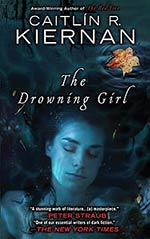
![]() Kata
Kata
9/8/2013
![]()
Hauntings. Ghosts. Sirens. Wolves. Mermaids. Drownings. Ravens. Schizophrenia. Suicides. Myths and Legends. Music. Paintings. Numbers. Murders.
When I first started reading The Drowning Girl by Caitlin R. Kiernan, I thought it was a bunch of semi-coherent ramblings. I was confused how it could have been nominated for five awards -- 2012 Nebula, 2012 Shirley Jackson, 2013 Locus Fantasy, 2013 Mythopoeic, 2013 World Fantasy – and won the 2012 Stoker. In time I began to see the patterns and the forms, the play of themes, the interplay of the literal and the metaphoric.
Briefly, the story is narrated by Imp, a lesbian and schizophrenic, whose mother and grandmother both committed suicide. At the beginning of the novel Imp talks about a painting, "The Drowning Girl," that she saw in a museum when she was eleven. Imp rescues two women. The first is Abalyn, a transsexual, who makes her living writing reviews of video games. Imp finds Abalyn's belongings out on the sidewalk after a messy breakup. Imp takes her back to her apartment, and they soon become girlfriends and lovers. The second woman whom Imp rescues is Eva. One night when Imp is out driving, she sees a naked woman along the side of the road. Imp takes her home. The true story of Eva, if it ever is actually revealed, is woven throughout the novel. Why does Imp think she met Eva twice? Why does Imp think that there are two Eva's? What really happened between Imp and Eva? Who is (are) the "drowning girl"?
The Drowning Girl is not an easy novel to read. It has some intense themes, and it requires mental energy to work through the ideas. I won't even pretend that I had it all figured out by the end. Even after finishing the novel, I still am seeing how all the ideas fit together.
(Review first published on my blog)
http://www.katachimesin.blogspot.com/